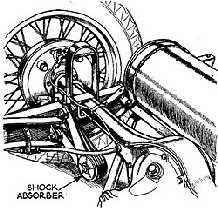Proponents of Cleantech Have Some Good Ideas — And Some Bad Ones Too
I come across new ideas for renewable energy and alternate fuel vehicles at a rate of perhaps a dozen a week. While (fortunately) there are a few good ones, most of them fail the most basic tests of science and common sense. Here’s a good example of the latter that I encountered at the EV show a couple of weeks ago: WattShocks. In brief, the theory is that a healthy portion of a car’s overall kinetic energy is currently dissipated as heat in a car’s shock absorbers and can be captured and used to recharge an electric vehicle’s battery.
At first blush, this is an interesting concept. Returning some of the horizontal component of a car’s kinetic energy as electricity works really well; it’s called regenerative braking, and it’s why hybrids get such good gas mileage. So is there anything theoretically impossible about Wattshocks’ idea? No. But could it possibly be in any way practical? Sorry, no.
In my discussion with one of the principals at the show, I asked him:
1) “How much of the overall kinetic energy of a moving vehicle is vertical, vs. horizontal?” He tried to avoid a direct response to the question, but the answer: an infinitesimally small percentage. The modeling software that EV designers use assumes this to be zero. It isn’t zero, of course, but it’s negligible.
2) “If you think this component is not negligible, can you explain why our present-day shock absorbers do not burn up?”
3) The purpose of shock absorbers is to provide driver/passenger comfort and to keep the car’s wheels on the road. Even if it weren’t for #1 and #2, changing their characteristics would have bad consequences.
Nice try, but no cigar.


That’s clever. It should be obvious that if shock absorbers dissipated a significant percentage of the power delivered to the driving wheels, that they would become very hot and obviously, they don’t. It’s true that the heat generated by shock absorbers can cause them to become warm enough to thin out the oil and thereby reduce the damping effect (which is why there are various methods used to reduce that effect), but obviously the heat generated isn’t enough that, if recovered, would significantly contribute towards driving the car. However, probably the energy dissipated by shock absorbers would be enough to recharge cell ‘phones or operate the car clock, but that would seem to be economically impractical to utilize.
At one time, an argument against suspension systems for bicycles was that they would dissipate energy that would otherwise be used to power the bicycle. However, the current prevalence of bicycles with suspension systems would seem to indicate that that theory was incorrect.
A knowledge of very basic physics is often enough to debunk hair-brained ideas.
Do you suppose that the hear energy dissipated by a car’s exhaust and cooling systems would be utilized to power the air conditioning? Perhaps via an absorption system?